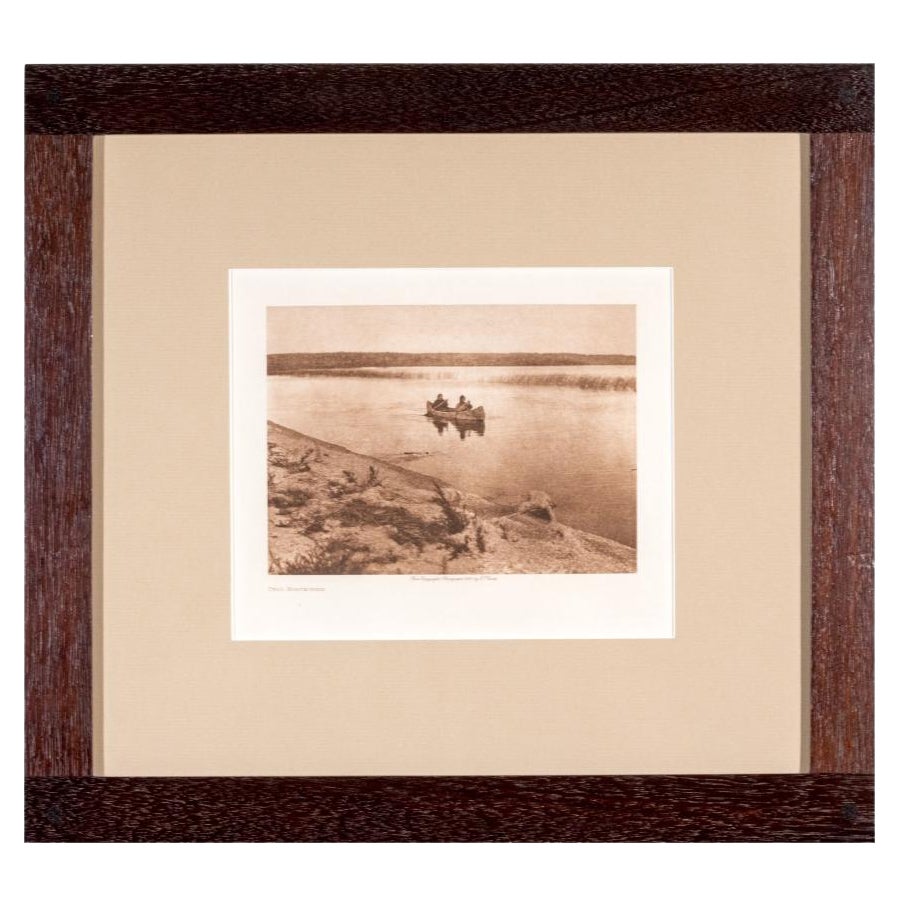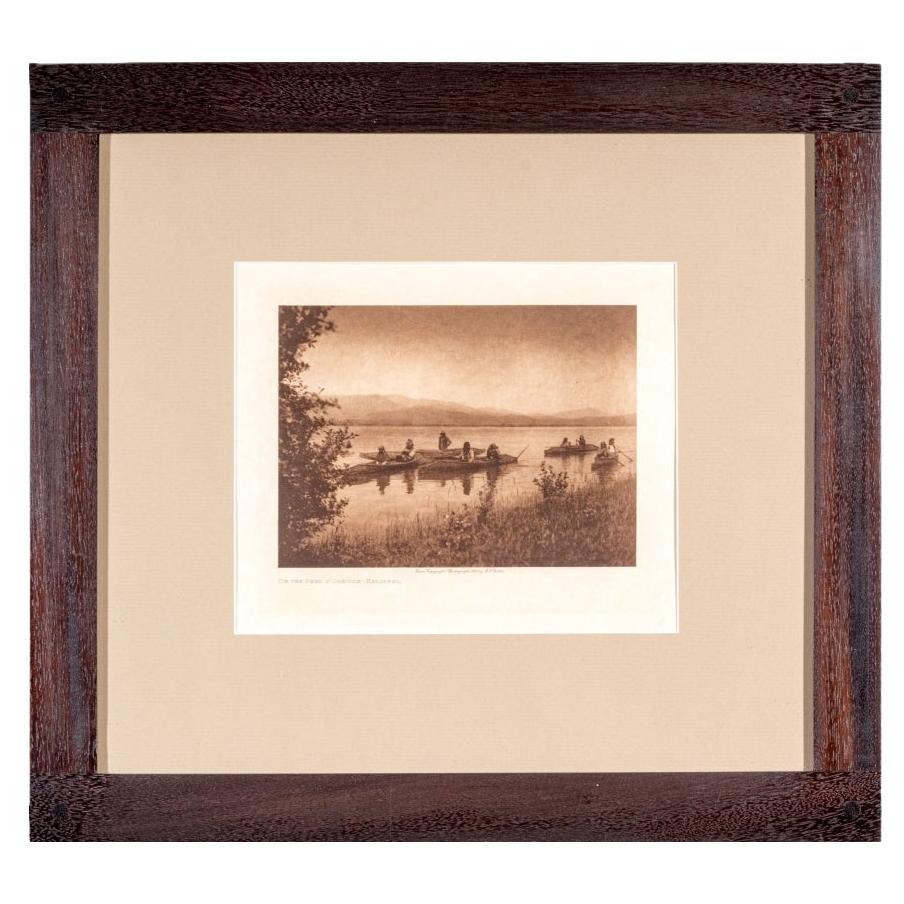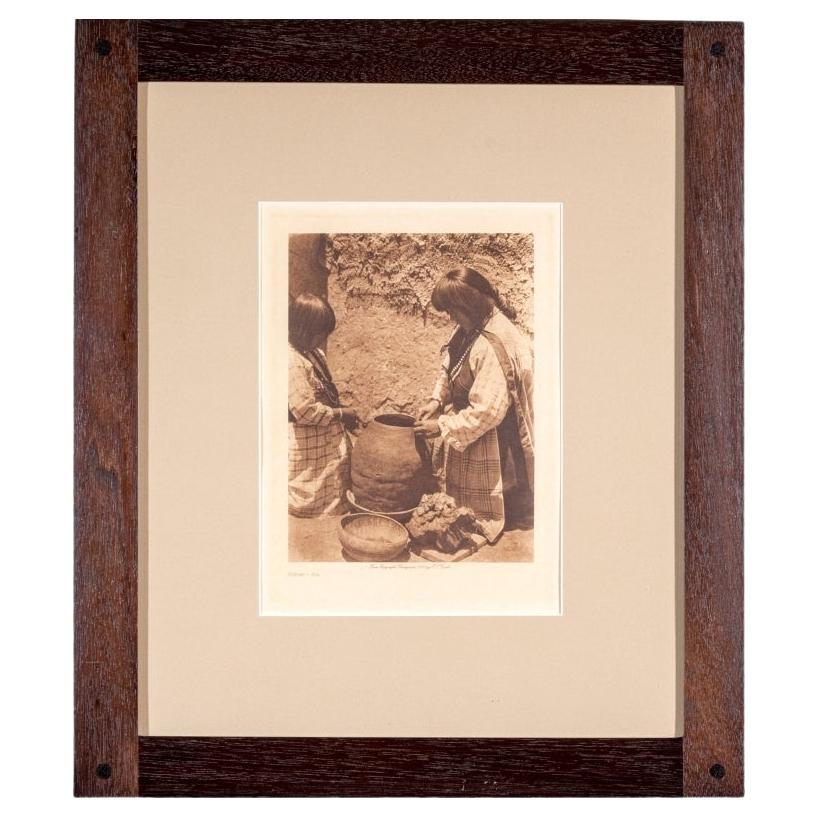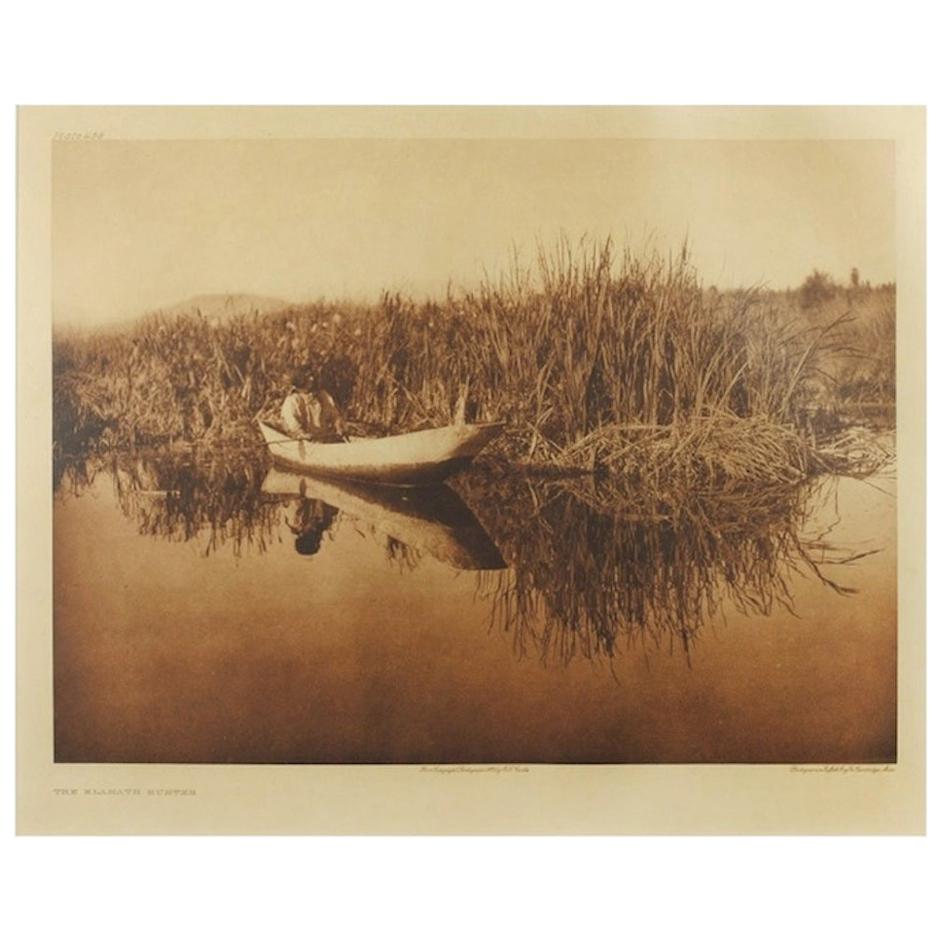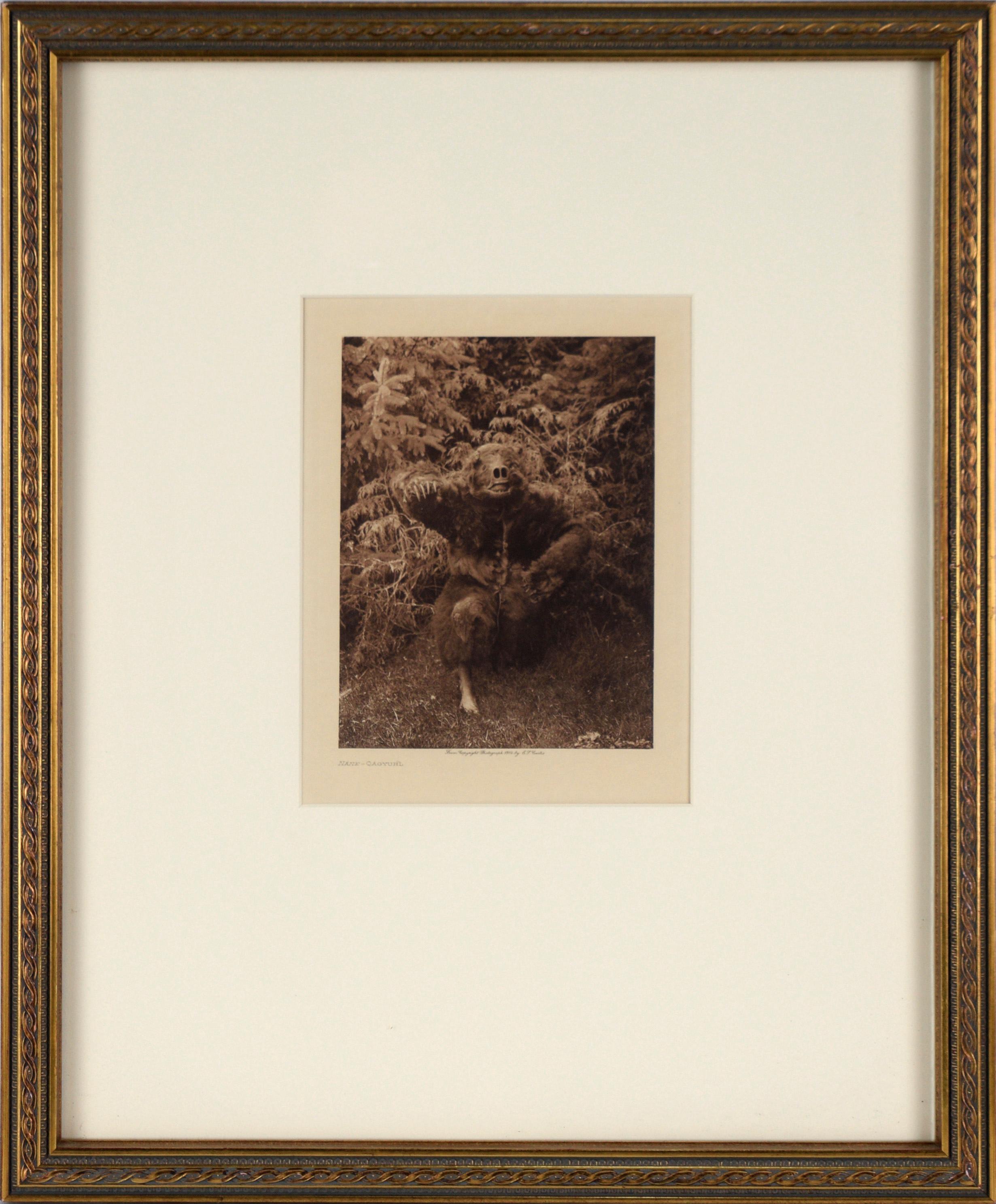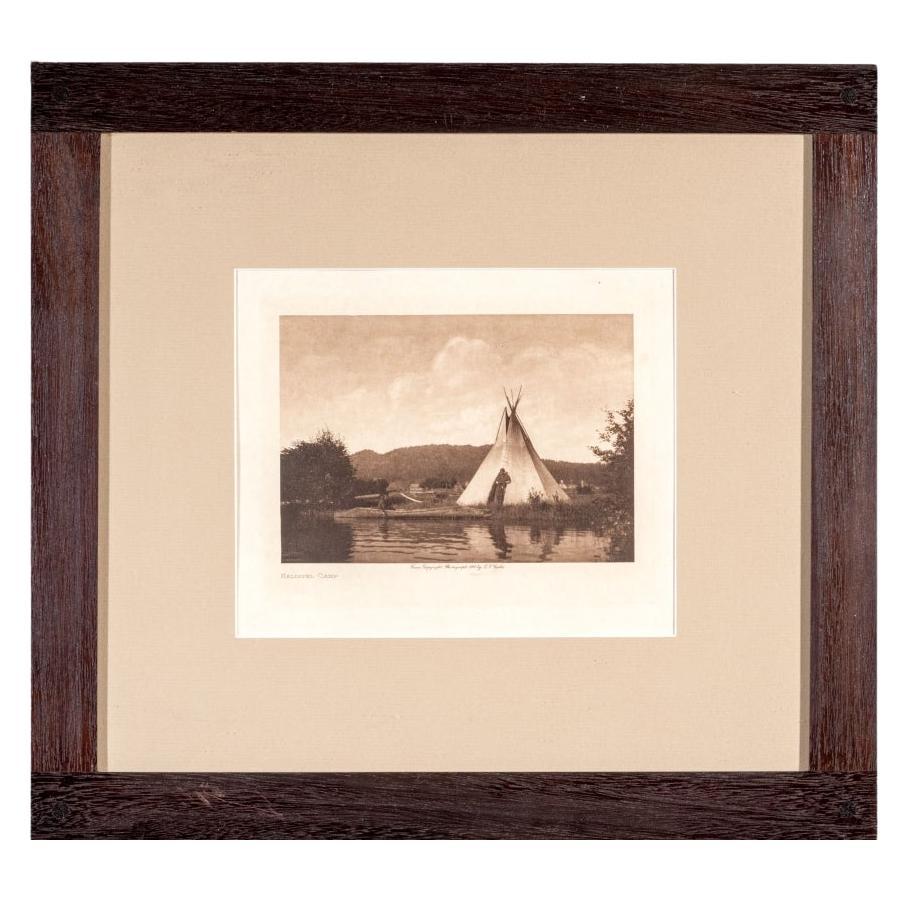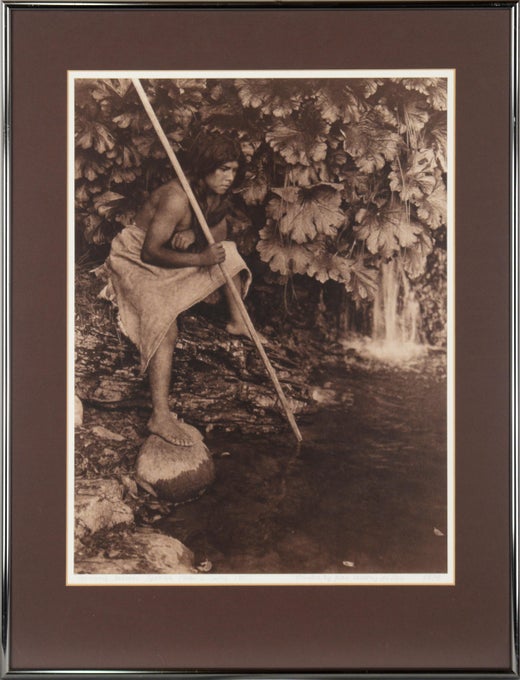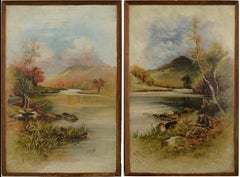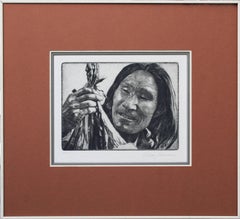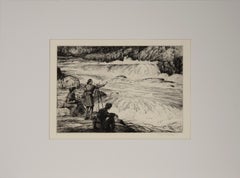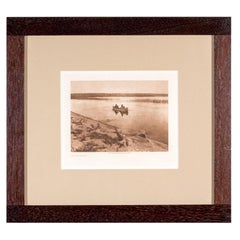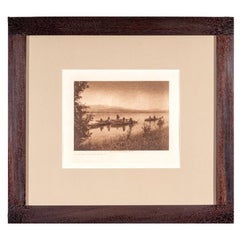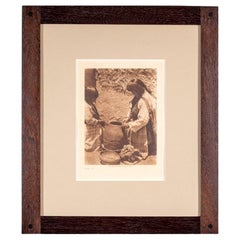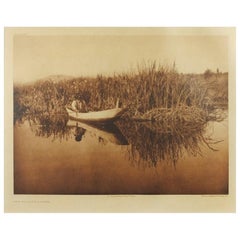Items Similar to "Spearing Salmon: Spokan", Sepia Photograph of Indigenous Spearfishing
Want more images or videos?
Request additional images or videos from the seller
1 of 14
Edward Sheriff Curtis"Spearing Salmon: Spokan", Sepia Photograph of Indigenous Spearfishing1974
1974
$750
£556.53
€648.28
CA$1,044.01
A$1,162.59
CHF 605.07
MX$14,334.65
NOK 7,705.98
SEK 7,242.87
DKK 4,836.97
Shipping
Retrieving quote...The 1stDibs Promise:
Authenticity Guarantee,
Money-Back Guarantee,
24-Hour Cancellation
About the Item
Silver and sepia tone photographic print of an indigenous spearfisher by Edward Sheriff Curtis, image circa 1901 (American, 1868-1952), as a 1974 copy of (and printed from negatives derived from) the original Edward Curtis copper gravure plate, by Jean-Antony du Lac (1929-2002). Curtis used a process he mastered of creating orotones, which are photographs on glass, which Jean-Anthony du Lac spent years mastering. Jean-Antony du Lac's work is considered that of a preservationist. Titled lower left, signed lower right. Presented in an aluminum frame with anti-glare glass. Paper size: 20"H x 15"W
Born in France and raised in New York City, Jean-Anthony du Lac moved west to San Francisco in 1957. Jean was an accomplished photographer whose published credits include Life Magazine and the San Francisco Examiner. He spent many years reproducing Edward S. Curtis' images of North American Indians; and he mastered the process of creating orotones, which are photographic reproductions on glass. Jean's orotones appeared on the walls of the Smithsonian as well as the White House during the Carter and Reagan administrations. A preservationist, his reproduction of Edward Muybridge's panorama of San Francisco still hangs in one prominent San Francisco hotel; and he was instrumental in organizing Proposition P in the early 1970s, which sought to preserve the old San Francisco skyline by limiting the height of all downtown skyscrapers. The majority of his life a mystery, Jean left behind no material possessions, save for a single key to a solitary padlock.
- Creator:Edward Sheriff Curtis (1868 - 1952, American)
- Creation Year:1974
- Dimensions:Height: 24.25 in (61.6 cm)Width: 18.25 in (46.36 cm)Depth: 0.75 in (1.91 cm)
- Medium:
- Movement & Style:
- Period:
- Condition:Minor scratches on frame. Vintage frame may show signs of wear consistent with age and history. Minor cosmetic issues will be minimized but may not be restored to original condition. New hanging hard-ware installed.
- Gallery Location:Soquel, CA
- Reference Number:Seller: JT-DBH73491stDibs: LU5429009972
Edward Sheriff Curtis
Born in France and raised in New York City, Jean-Anthony du Lac moved west to San Francisco in 1957. Jean was an accomplished photographer whose published credits include Life Magazine and the San Francisco Examiner. He spent many years reproducing Edward S. Curtis' images of North American Indians; and he mastered the process of creating orotones, which are photographic reproductions on glass. Jean's orotones appeared on the walls of the Smithsonian as well as the White House during the Carter and Reagan administrations. A preservationist, his reproduction of Edward Muybridge's panorama of San Francisco still hangs in one prominent San Francisco hotel; and he was instrumental in organizing Proposition P in the early 1970s, which sought to preserve the old San Francisco skyline by limiting the height of all downtown skyscrapers. The majority of his life a mystery, Jean left behind no material possessions, save for a single key to a solitary padlock.
About the Seller
5.0
Platinum Seller
Premium sellers with a 4.7+ rating and 24-hour response times
Established in 1986
1stDibs seller since 2014
2,943 sales on 1stDibs
Typical response time: <1 hour
- ShippingRetrieving quote...Shipping from: Soquel, CA
- Return Policy
Authenticity Guarantee
In the unlikely event there’s an issue with an item’s authenticity, contact us within 1 year for a full refund. DetailsMoney-Back Guarantee
If your item is not as described, is damaged in transit, or does not arrive, contact us within 7 days for a full refund. Details24-Hour Cancellation
You have a 24-hour grace period in which to reconsider your purchase, with no questions asked.Vetted Professional Sellers
Our world-class sellers must adhere to strict standards for service and quality, maintaining the integrity of our listings.Price-Match Guarantee
If you find that a seller listed the same item for a lower price elsewhere, we’ll match it.Trusted Global Delivery
Our best-in-class carrier network provides specialized shipping options worldwide, including custom delivery.More From This Seller
View All"Nane - Qagyuhl" Native American in Grizzly Costume - Photogravure Print
By Edward Curtis
Located in Soquel, CA
"Nane - Qagyuhl" Native American in Grizzly Costume - Photogravure Print
Photogravure of a Native American man from a photo by Edward Sheriff Curtis (American, 1868-1952). The man i...
Category
Early 20th Century Photorealist Figurative Prints
Materials
Paper, Ink
Two Early Massachusetts Paintings Boy fishing "Beaver Pool" - "The Conway" 1897
Located in Soquel, CA
Two Early Massachusetts Paintings Boy fishing "Beaver Pool" - "The Conway" 1897
Pair of early Massachusetts paintings on walnut wood pane...
Category
1890s American Impressionist Figurative Paintings
Materials
Oil, Wood Panel
The Hunter, Mid-Century Photo Realist Drypoint Etching Portrait, Limited Edition
By Gilbert Schoenbrod
Located in Soquel, CA
An incredible photo-realist drypoint etching of a Native American man by Gilbert Adam Shoenbrod (American, 1903-1996), 1937. Titled "The Hunter", this hyper detailed portrait depicts...
Category
1930s Photorealist Figurative Prints
Materials
Drypoint
"Conquering The Wilderness" - Lewis and Clark Expedition Original Etching
By Robert Hogg Nisbet
Located in Soquel, CA
"Conquering The Wilderness" - Lewis and Clark Expedition Original Etching
Original 1932 black and white etching titled "Conquering The Wilderness" by Robert Hogg Nisbet (American, ...
Category
1930s American Impressionist Figurative Prints
Materials
Laid Paper, Etching
Alaska Forest Stream - Black & White Landscape Photograph
Located in Soquel, CA
Beautiful black & white landscape photograph of forest trees and stream in the woods of Alaska, by Anchorage-based nature photographer George Provost (American, 20th Century). Hand signed and dated "George Provost 1989" lower right. Photograph is hand made from an 8x10 camera negative in a traditional "wet" darkroom, by the photographer. Mounted on white mat board. Unframed. Image size: 19"H x 15"W.
Born in California, Provost grew up in the Bay Area. He has lived and worked in Alaska since 1987, specializing in large format, fine art, black and white photography. His work has been exhibited in over 60 exhibitions, received numerous awards, and is included in hundreds of collections, both public and private.
George Provost was an Isle Royale...
Category
1980s American Realist Black and White Photography
Materials
Photographic Paper, Silver Gelatin
Drying Salmon Native American Smoke Tent - Figurative Oil on Canvas
Located in Soquel, CA
Brightly colored depiction of a Native American Smoking Salmon a West Coast river by an unknown artist (20th Century). A man in a white shirt and hat sits and sorts his Salmon on the...
Category
Late 20th Century Impressionist Figurative Paintings
Materials
Canvas, Oil
$680 Sale Price
20% Off
You May Also Like
Edward S. Curtis (1868-1952) Scarce Sepia Photogravure Titled "Cree Boatwomen"
By Edward S. Curtis, 1868-1952
Located in Bridgeport, CT
Sepia photogravure titled "Cree Boatwomen" depicting Native American women in boat on a lake.
The photogravure is titled lower left "Cree Boatwomen". Printed under the photogravure "...
Category
20th Century American Native American Photography
Materials
Acrylic, Wood, Paper
Edward S. Curtis (1868-1952) Sepia Photogravure On The Pend D'Oreille - Kalispel
By Edward S. Curtis, 1868-1952
Located in Bridgeport, CT
Sepia photogravure titled "On the Pend d'Oreille - Kalispel" depicting native figures in canoes on the water, more than likely the Pend D'Oreille River in areas that encompassed land...
Category
20th Century American Native American Photography
Materials
Acrylic, Wood, Paper
Edward S. Curtis (1868-1952) Scarce Sepia Photogravure Titled Tsipiai - Sia
By Edward S. Curtis, 1868-1952
Located in Bridgeport, CT
Sepia photogravure titled "Tsipiai - Sia" depicting native women engaged in pottery making.
The photogravure is titled lower left "Tsipiai - Sia". Printed under the photogravure "Fro...
Category
20th Century American Native American Photography
Materials
Acrylic, Wood, Paper
Original Edward S. Curtis Photogravure, "The Klamath Hunter" 1923
By Edward S. Curtis, 1868-1952
Located in Colorado Springs, CO
Presented is a beautiful photogravure showing a Klamath man hunting from a dugout canoe. This image is Plate 458 from Volume 13 of Edward Curtis' epic project The North American Indian. The photogravure was published in 1923 by Suffolk Engr. Co., in Cambridge, MA. The Klamath people are from the inland region of Northern California and Southern Oregon. Their oral history records the volcanic eruption that created Crater Lake over 7000 years ago
Edward S. Curtis created one of the most enduring and iconic visual records in the history of the photographic medium. He was an award-winning artist, a consummate craftsman, a visionary, an intrepid entrepreneur, and was highly regarded as a respected ethnographer and publisher.
Curtis began photographing Native Americans in the mid-1890s and selling these images in his successful downtown Seattle studio. One of his earliest models was Princess Angeline, the aged daughter of chief Sealth, the Suquamish Indian after whom Seattle is named. At the National Photographic Convention of 1899 Curtis was awarded the grand prize for three of his soft-focused, sepia-toned images of Puget Sound Native Americans: Evening on the Sound, The Clam Digger, and The Mussel Gatherer.
Curtis spent the summer of 1900 with George Bird Grinnell observing the Sun Dance at an encampment of Blood, Blackfeet, and Algonquin in Montana. This was a pivotal experience for Curtis, confirming his desire to study and photograph the Native tribes of North America. A trip to visit the Hopi reservation in Arizona a few months later further fueled his enthusiasm.
Curtis envisioned a plan to create a massive scholarly and artistic work that would document the tribes west of the Mississippi, their ceremonies, beliefs, daily life, and landscapes. In 1906, Curtis approached railroad tycoon J.P. Morgan to request financial assistance for his project. Morgan agreed to pay him a total of $75,000, or $15,000 a year for five years. Morgan and Curtis decided that Curtis' masterwork, The North American Indian, would be a set of 20 volumes of ethnographic text illustrated with high quality photoengravings taken from his glass plate negatives. Each of these volumes would be accompanied by a portfolio of large size images, all sumptuously bound in Moroccan leather. The papers used for printing would also be of the best quality: a Dutch etching stock by Van Gelder, a Japanese vellum, and for the most discerning subscribers, a translucent Japanese tissue paper. To fund publication, Curtis would sell subscriptions at approximately $3,000 per set, with a total of 500 sets to be published.
An ambitious and extensive project, Curtis spent much of his life documenting as many Native tribes as possible. The importance and the urgency of the task was clear to him, as he wrote in the introduction to his first volume of The North American Indians in 1907, "The information that is to be gathered ... respecting the mode of life of one of the great races of mankind, must be collected at once or the opportunity will be lost." In 1930, some 24 years after his initial request for funding, the last two volumes, Vol. 19 and Vol. 20, were published and The North American Indian project was finally completed. Curtis took over 40,000 photographs and made over 10,000 wax cylinder...
Category
Vintage 1920s American Photography
Materials
Paper
Edward S. Curtis (1868-1952) Scarce Sepia Photogravure Titled "Kalispel Camp"
By Edward S. Curtis, 1868-1952
Located in Bridgeport, CT
Sepia photogravure titled "Kalispel Camp" depicting native figures in the foreground with kayak and teepee and rolling hills in the distance.
The photogravure is titled lower left "K...
Category
20th Century American Native American Photography
Materials
Acrylic, Wood, Paper
Edward S. Curtis Original Signed Stamped Platinum Photograph Hopi Weaver, 1899
By Edward S. Curtis, 1868-1952
Located in Studio City, CA
An original platinum print on textured paper by iconic American photographer Edward Curtis titled "Hopi Weaver"(sometimes known as "The Weaver"). Curtis was famed for his work with the Native American peoples of the American West at the turn of the century. This image features a male Hopi elder weaving a blanket - an exclusively masculine occupation at the time.
This platinum print is hand-signed in ink, blind-stamped with Curtis' embossed studio copyright stamp, and dated 1899. The negative number ("X 743") can possibly also be imperceptibly/faintly seen written by Curtis on the lower-left edge. The photo is mounted on a single, handmade lightweight paper typical of other mounted Curtis photos...
Category
Antique 1890s American Native American Photography
Materials
Wood, Paper
